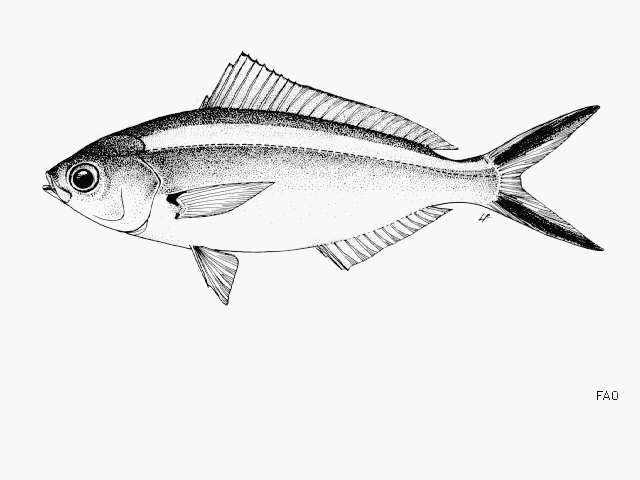Caesio
caerulaurea
Lacepède,
1801
Blue and gold fusilier
View all media / Upload your photos and videos
Expand all
Classification / Names
Teleostei (teleosts) > Eupercaria/misc (Various families in series Eupercaria) >
Caesionidae (Fusiliers)
> Caesioninae
Etymology: Caesio: Latin, caesius, bluish-grey, 1835; it is the same name given to the silvery metal (Cs) (Ref. 45335).
More on author:
Lacepède.
Environment / milieu / depth range / climate zone / distribution range
Distribution
Indo-West Pacific: Red Sea and East Africa to Samoa, north to southern Japan, south to New Caledonia. Absent in the Arabian (Persian) Gulf.
Maps

Caesio caerulaurea / Native range
AquaMaps Data sources:
GBIF
OBIS
This map was computer-generated and has not yet been reviewed.

Caesio caerulaurea / Suitable habitat
AquaMaps Data sources:
GBIF
OBIS
This map was computer-generated and has not yet been reviewed.

Caesio caerulaurea / Point map
AquaMaps Data sources:
GBIF
OBIS
This map was computer-generated and has not yet been reviewed.

Caesio caerulaurea / Year 2050
AquaMaps Data sources:
GBIF
OBIS
This map was computer-generated and has not yet been reviewed.
Size / Weight / Age
Short description
Dorsal spines (total): 10; Dorsal soft rays (total): 14 - 16; Anal spines: 3; Anal soft rays: 10 - 12. This species is distinguished by the following characters: postmaxillary process single; A III,12 (rarely 13); lateral line scales 57-65 (usually around 61); scale rows on spinous part of dorsal fin horizontal; supratemporal bands of scales often interrupted at dorsal midline by a scaleless zone, always a V-shaped scaleless zone anteriorly at midline intruding between the supratemporal band of scales; body colour with upper body bluish and the lower white to pale bluish; a single yellow or golden stripe directly above lateral line except on caudal peduncle where it is about 1 scale above lateral line, the yellow stripe 2 or 3 scales wide, bordered directly above and below by a white or light blue stripe which is about 1 scale wide, caudal-fin lobes with a black median streak (Ref. 68703). Description: Body moderately deep, fusiform, elongate, and moderately compressed. Ratio of eye diameter to head length usually around 3.4-4.2; D X,15 (rarely 14 or 16); pectoral fins with 20 to 22 (rarely 19); scale rows above lateral line to origin of dorsal fin 7-10 (most frequently 9); scale rows below lateral line to origin of anal fin usually 15-18; predorsal scales 20-26; dorsal and anal fins scaled; greatest body depth 2.2-3.1 in SL, head length 2.7-3.4 in SL (Ref. 68703, 90102).
Biology
Life cycle and mating behavior
Mating behavior is marked by six distinguishable patterns, namely: 1) nuzzling; 2) several males joining in courtship; 3) spiraling towards the surface; 4) pair spawning; 5) sperm release by sneakers; and 6) post spawning. Nuzzling is done about 1-1.5 hours before spawning. For most of the day the fish swam slowly in school. At nearly spawning time, one or two males approach a selected female and begin pecking and pushing her swollen abdomen with their snouts. Interruption happens at this stage resulting in spawners returning to the school. With less than an hour until spawning, 2-6 males may attempt to get their abdomen as close to the female's abdomen as possible. For the pair that completes this position, a spiraling ascent to the surface occurs followed by a release of both eggs and sperm while other males come in pursuit. These sneakers release sperm at the same spot where the initial pair had released their gametes. Some spawnings may occur without sneakers getting involved in the process (Ref. 37498).
Main reference
Carpenter, K.E. 1987 Revision of the Indo-Pacific fish family Caesionidae (Lutjanoidea), with descriptions of five new species. Indo-Pac. Fish. (15):56 p. (Ref. 1723)
IUCN Red List Status (Ref. 125652)
Least Concern (LC); date assessed: February 04 2009
CITES (Ref. 131153)
Not Evaluated
CMS (Ref. 116361)
Not Evaluated
Threat to humans
Harmless
More information
- Countries
- FAO areas
- Ecosystems
- Occurrences
- Introductions
- Stocks
- Ecology
- Diet
- Food items
- Food consumption
- Ration
- Common names
- Synonyms
- Metabolism
- Predators
- Ecotoxicology
- Reproduction
- Maturity
- Spawning
- Spawning aggregation
- Fecundity
- Eggs
- Egg development
- Age/Size
- Growth
- Length-weight
- Length-length
- Length-frequencies
- Morphometrics
- Morphology
- Larvae
- Larval dynamics
- Recruitment
- Abundance
- References
- Aquaculture
- Aquaculture profile
- Strains
- Genetics
- Allele frequencies
- Heritability
- Diseases
- Processing
- Mass conversion
- Vision
- Pictures
- Stamps, Coins Misc.
- Sounds
- Ciguatera
- Speed
- Swim. type
- Gill area
- Otoliths
- Brains
Estimates based on models
Preferred temperature (Ref. 123201): 24.7 - 29, mean 28 °C (based on 814 cells).
Phylogenetic diversity index (Ref. 82804): PD50 = 0.502 [Uniqueness, from 0.5 = low to 2.0 = high].
Bayesian length-weight: a=0.01514 (0.00955 - 0.02398), b=3.04 (2.91 - 3.17), in cm total length, based on LWR estimates for this species & (Sub)family-body (Ref. 93245).
Trophic level (Ref. 69278): 3.4 ±0.5 se; Based on food items.
Resilience (Ref. 120179): Medium, minimum population doubling time 1.4 - 4.4 years (Preliminary K or Fecundity.).
Fishing vulnerability (Ref. 59153): Moderate vulnerability (40 of 100).
Price category (Ref. 80766): Medium; Questionable: based on ex-vessel price for species in this genus.
Nutrients (Ref. 124155): Calcium = 58.9 [38.9, 86.2] mg/100g; Iron = 0.742 [0.489, 1.080] mg/100g; Protein = 19 [18, 20] %; Omega3 = 0.141 [0.098, 0.203] g/100g; Selenium = 32.6 [20.7, 55.2] μg/100g; VitaminA = 102 [42, 251] μg/100g; Zinc = 1.14 [0.83, 1.52] mg/100g (wet weight);









